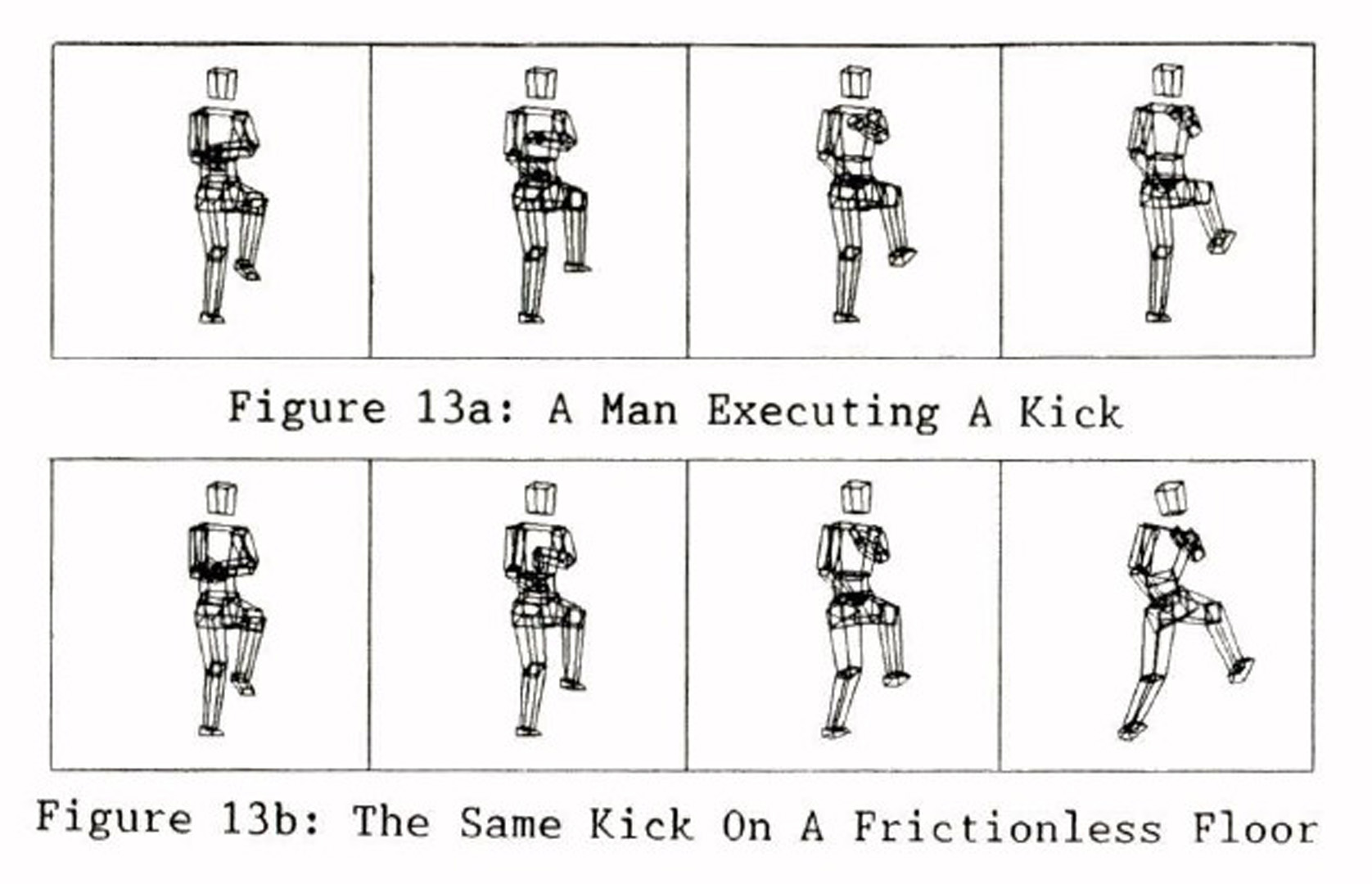“Controlling dynamic simulation with kinematic constraints” by Isaacs and Cohen
Conference:
Type(s):
Title:
- Controlling dynamic simulation with kinematic constraints
Presenter(s)/Author(s):
Abstract:
Theoretical and numerical aspects of the implementation of a DYNAmic MOtion system, dubbed DYNAMO, for the dynamic simulation of linked figures is presented. The system introduces three means for achieving, control of the resulting motion which have not been present in previous dynamic simulation systems for computer animation. (1) “Kinematic constraints” permit traditional keyframe animation systems to be embedded within a dynamic analysis. Joint limit constraints are also handled correctly through kinematic constraints. (2) “Behavior functions” relate the momentary state of the dynamic system to desired forces and accelerations within the figure. (3) “Inverse dynamics” provides a means of determining the forces required to perform a specified motion.The combination of kinematic and dynamic specifications allows the animator to think about each part of the animation in the way that is most suitable for the task. Successful experimental results are presented which demonstate the ability to provide control without disrupting the dynamic integrity of the resulting motion.
References:
1. Armstrong, William W., and Green, Mark W., “The Dynamics of Articulated Rigid Bodies for Purposes of Animation,” The Visual Computer, Vol. I, 4, Springer Verlag, December 1985, pp.231-240
2. Badler, Norman I., et el., “Multi-Dimensional Input Techniques and Articulated Figure Positionaing By Multiple Constraints,” 1986 Workshop on Interactive 3D Graphics, Chapel Hill, North Carolina, October 1986~
3. Conte, Samuel D., and de Boor, Carl, Elementary Numerical Analysis, An Algorithmic Approach, (Third Edition), Mcgraw-Hill Book Company, New York, N.Y., 1980, pp.379-389.
4. Featherstone, R., “The Calculation of Robot Dynamics Using Articulated-Body Inertias,” The International Journal of Robotics Research, Vol. 2, No. 1, Spring 1983, pp.13-30.
5. Girard, Michael, and Maciejewski, A. A., “Computational Modelling for the Computer Animation of Legged Figures,” ACM COMPUTER GRAPHICS (Siggraph Proc. ’85), July 1985, pp.263-270.
6. Girard, Michael, “Interactive Design of 3-D Computer-Animated Legged Animal Motion,” Ig86 Workshop on Interactive 3D Graphics, Chapel Hill, North Carolina, October 1986.
7. Hornbeck, Robert W., Numerical Methods, Quantum P u b l i s h e r s , New York, NY, 1 9 7 4 , pp.199-202.
8. Korein, James U., and Badler, Norman I., “Techniques for Generating the Goal-Directed Motion of Articulated Structures,” IEEE Computer Graphics Applications, November 1982, pp.71-81.
9. Luh, J., Walker M., Paul R., “On-line Computational Scheme for Mechanical Manipulators,” in Robot Motion, Planning and Control, edited by Brady et. el., M.I.T. Press, pp.89-i06.
10. O’Donaell, T.J., and Olson, Arthur J. “GRAMPS – A Graphics Language Interpreter for Real-Time, Interactive, Three-Dimensional Picture Editing and Animation,” ACM COMPUTER GRAPHICS (Siggraph Proc. ’81), August 1981, pp. 133-142.
11. Raibert, Marc H., et. al., “Experiments in Balance with a 3D One-Legged Hopping Machine,” The International Journal of Robotics Research, Vol. 3, No. 2, Summer 1984, pp.75-92.
12. Stern, Garland, “Bbop A Program for 3-Dimensional Animation,” Nico~raph ’83 Proceedings, December 1983, pp.403-404.
13. Wilhelms, Jane, and Barsky, Brian. “Using Dynamic Analysis to Animate Articulated Bodies Such as Humans and Robots,” Proceedings, Graphics Interface ’85, May 1985, pp,97-I04.
14. Williams, R.J., and Seireg, A., “Interactive Modeling and Analysis of Open or Closed Loop Dynamic Systems with Redundant Actuators,” Journal of Mechanical Design (Transactions of the ASME), Vol. I01, July 1979, pp.407-416
15. Wittenberg, Jens, Dynamics of Systems of Rigid Bodies, B.G. Teubner, Stuttgart, Germany, 1977.




